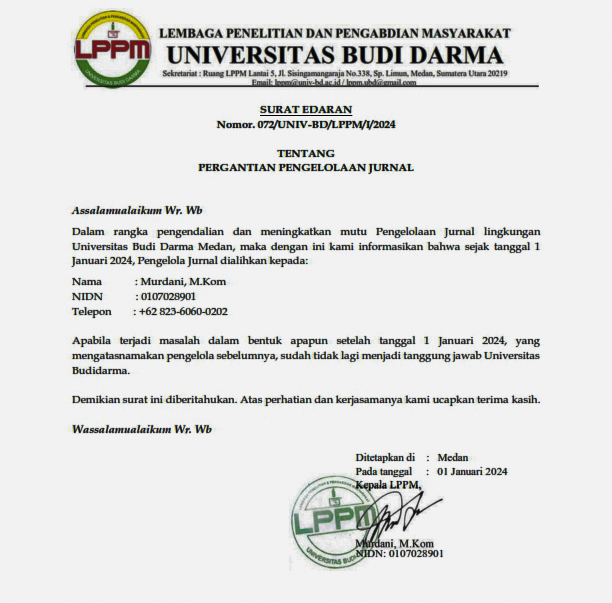Klasifikasi Kanker Payudara Menggunakan Metode Convolutional Neural Network (CNN) dengan Arsitektur VGG-16
DOI:
https://doi.org/10.30865/json.v5i3.7553Keywords:
Breast Cancer, Classifiaction, Convolutional Neural Network, VGG-16Abstract
Breast cancer classification is a process to determine the type and characteristics of breast cancer based on the characteristics of cancer cells. In this research, a system is designed to classify breast cancer using ultrasound images which are then processed using the Convolutional Neural Network method with the VGG-16 architecture. The aim of the research is to develop a breast cancer classification system using Convolutional Neural Network (CNN) and evaluate the classification results using Convolutional Neural Network (CNN) with the VGG-16 architecture. In breast cancer classification, three classes are considered: normal, benign, and malignant. The steps in the classification process include image input, filtering, resizing, data augmentation, and data digitization. The best results were obtained in this test using the SGD optimizer hyperparameter, learning rate 0.001, epoch 20 and batch size 32 producing an accuracy value of 78.87%, a precision value of 75.69%, an AUC value of 79.85% and an f1 score value of 74.67%.
References
G. Aji mahesa, “Klasifikasi Citra Histologi Kanker Payudara Menggunakan Metode Ensemble CNN,†Jurnal Repositor, vol. 4, no. 3, pp. 373–384, 2022, doi: 10.22219/repositor.v4i3.1497.
A. Parvaiz, M. A. Khalid, R. Zafar, H. Ameer, M. Ali, and M. M. Fraz, “Vision Transformers in medical computer vision—A contemplative retrospection,†Engineering Applications of Artificial Intelligence, vol. 122. Elsevier Ltd, Jun. 01, 2023. doi: 10.1016/j.engappai.2023.106126.
L. Hansel, G. #1, H. Bunyamin, and S. Si, “Penggunaan Augmentasi Data pada Klasifikasi Jenis Kanker Payudara dengan Model Resnet-34,†2021. [Online]. Available: https://cs231n.github.io/convolutional-networks/
Z. Khandezamin, M. Naderan, and M. J. Rashti, “Detection and classification of breast cancer using logistic regression feature selection and GMDH classifier,†Journal of Biomedical Informatics, vol. 111, Nov. 2020, doi: 10.1016/j.jbi.2020.103591.
Z. Hameed, S. Zahia, B. Garcia-Zapirain, J. J. Aguirre, and A. M. Vanegas, “Breast cancer histopathology image classification using an ensemble of deep learning models,†Sensors (Switzerland), vol. 20, no. 16, pp. 1–17, Aug. 2020, doi: 10.3390/s20164373.
M. A. Rohman, P. Mudjirahardjo, and M. A. Muslim, “IMPLEMENTASI FILTER GRAY LEVEL CO-OCCURANCE MATRIKS TERHADAP SISTEM KLASIFIKASI KANKER PAYUDARA DENGAN METODE CONVOLUTIONAL NEURAL NETWORK,†Transmisi, vol. 23, no. 4, 2021, doi: 10.14710/transmisi.23.4.160-168.
U. Sajid, R. A. Khan, S. M. Shah, and S. Arif, “Breast cancer classification using deep learned features boosted with handcrafted features,†Biomedical Signal Processing and Control, vol. 86, Sep. 2023, doi: 10.1016/j.bspc.2023.105353.
F. F. Ting, Y. J. Tan, and K. S. Sim, “Convolutional neural network improvement for breast cancer classification,†Expert Systems with Applications, vol. 120, pp. 103–115, Apr. 2019, doi: 10.1016/j.eswa.2018.11.008.
J. Jumadi, and D. Sartika, “PENGOLAHAN CITRA DIGITAL UNTUK IDENTIFIKASI OBJEK MENGGUNAKAN METODE HIERARCHICAL AGGLOMERATIVE CLUSTERINGâ€, 2021
D. Sudaryono, U. Rahardja, and A. Roihan, “Design of Business Intelligence in Learning Systems Using iLearning Media,†Universal Journal of Management, vol. 5, no. 5, pp. 227–235, May 2017, doi: 10.13189/ujm.2017.050502.
J. K. Chukwu, F. B. Sani, and A. S. Nuhu, “Breast Cancer Classification Using Deep Convolutional Neural Networks,†FUOYE Journal of Engineering and Technology, vol. 6, no. 2, 2021, doi: 10.46792/fuoyejet.v6i2.617.
A. P. Wibawa, M. Guntur, A. Purnama, M. Fathony Akbar, and F. A. Dwiyanto, “Metode-metode Klasifikasi,†Prosiding Seminar Ilmu Komputer dan Teknologi Informasi, vol. 3, no. 1, 2018.
J. Ker, L. Wang, J. Rao, and T. Lim, “Deep Learning Applications in Medical Image Analysis,†IEEE Access, vol. 6, pp. 9375–9379, Dec. 2017, doi: 10.1109/ACCESS.2017.2788044.
E. O. Simonyan, J. A. Badejo, and J. S. Weijin, “Histopathological breast cancer classification using CNN,†Materials Today: Proceedings, Nov. 2023, doi: 10.1016/j.matpr.2023.10.154.
K. Liu, G. Kang, N. Zhang, and B. Hou, “Breast Cancer Classification Based on Fully-Connected Layer First Convolutional Neural Networks,†IEEE Access, vol. 6, pp. 23722–23732, Mar. 2018, doi: 10.1109/ACCESS.2018.2817593.
F. Shahidi, S. M. Daud, H. Abas, N. A. Ahmad, and N. Maarop, “Breast cancer classification using deep learning approaches and histopathology image: A comparison study,†IEEE Access, vol. 8, pp. 187531–187552, 2020, doi: 10.1109/ACCESS.2020.3029881.
K. Simonyan and A. Zisserman, “Very Deep Convolutional Networks for Large-Scale Image Recognition,†Sep. 2014, [Online]. Available: http://arxiv.org/abs/1409.1556
X. Cheng, L. Tan, and F. Ming, “Feature Fusion Based on Convolutional Neural Network for Breast Cancer Auxiliary Diagnosis,†Mathematical Problems in Engineering, vol. 2021, 2021, doi: 10.1155/2021/7010438.
J. Wu and C. Hicks, “Breast cancer type classification using machine learning,†Journal of Personalized Medicine, vol. 11, no. 2, pp. 1–12, Feb. 2021, doi: 10.3390/jpm11020061.
T. Saito and M. Rehmsmeier, “The precision-recall plot is more informative than the ROC plot when evaluating binary classifiers on imbalanced datasets,†PLoS ONE, vol. 10, no. 3, Mar. 2015, doi: 10.1371/journal.pone.0118432.
Downloads
Published
How to Cite
Issue
Section
License

This work is licensed under a Creative Commons Attribution 4.0 International License
Authors who publish with this journal agree to the following terms:
- Authors retain copyright and grant the journal right of first publication with the work simultaneously licensed under Creative Commons Attribution 4.0 International License that allows others to share the work with an acknowledgment of the work's authorship and initial publication in this journal.
- Authors are able to enter into separate, additional contractual arrangements for the non-exclusive distribution of the journal's published version of the work (e.g., post it to an institutional repository or publish it in a book), with an acknowledgment of its initial publication in this journal.
- Authors are permitted and encouraged to post their work online (e.g., in institutional repositories or on their website) prior to and during the submission process, as it can lead to productive exchanges, as well as earlier and greater citation of published work (Refer to The Effect of Open Access).





